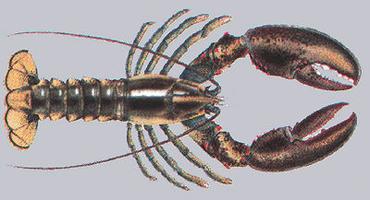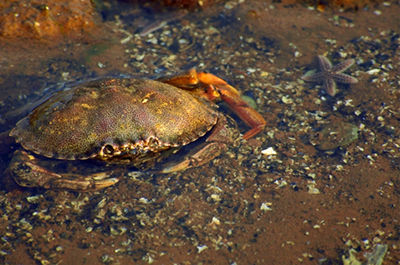In Canada, all crustacean species with significant economic value are in the order Decapoda. Decapods, which have five pairs of walking legs, include lobsters, crab and shrimp. These species constitute most of the dollar value of Canadian fisheries. In some areas, particularly in the Atlantic provinces, the local economy is almost completely dependent on them.

Crustaceans are shelled invertebrates with segmented bodies and limbs at some stage of their life, an exoskeleton and two pairs of antennae. Most crustaceans live in water. The American lobster (Homarus americanus) is the most valuable of these resources. Freshly caught lobster may be shipped live immediately to points in North America, Europe and Asia, or held in pounds until demand and price are more favourable. A much smaller percentage is cooked and canned or frozen.
Some areas in the Gulf of St. Lawrence have special fisheries for “canner” lobsters, which are slightly smaller than the “market” sizes. Despite what their name suggests, canners are not used for canning only. Prince Edward Island is a major harvester of canner lobsters.
In 2018, more than 97,000 tonnes of lobster were landed (put ashore) along the Atlantic coast, valued at $1.4 billion. This was more than the combined value of the crab and shrimp catch. On the East Coast, snow or queen crab (Chionoecetes opilio) is the most valuable crab species ($748 million in 2018). Shrimp had a landed value of $365 million.
Did you know?
Snow crab and lobster became staples of the East Coast fishing industry after the collapse of cod stocks led to the cod moratorium of 1992. In the early 2000s, scientists began warning that snow crab stocks were also showing signs of decline. In 2017, the Department of Fisheries and Oceans announced the snow crab population had declined by more than 80 per cent in less than four years.
In British Columbia waters, crab species including the Dungeness crab (Cancer magister) are the most valuable crustaceans ($64 million in 2018). Shrimp were next in value in ($44 million).
Because of the seasonality and unpredictable yield of the harvest fisheries, aquaculture of valuable species is an attractive prospect. However, aside from a small amount of crayfish farming in BC, no crustaceans are commercially farmed in Canada.

 Share on Facebook
Share on Facebook Share on X
Share on X Share by Email
Share by Email Share on Google Classroom
Share on Google Classroom















